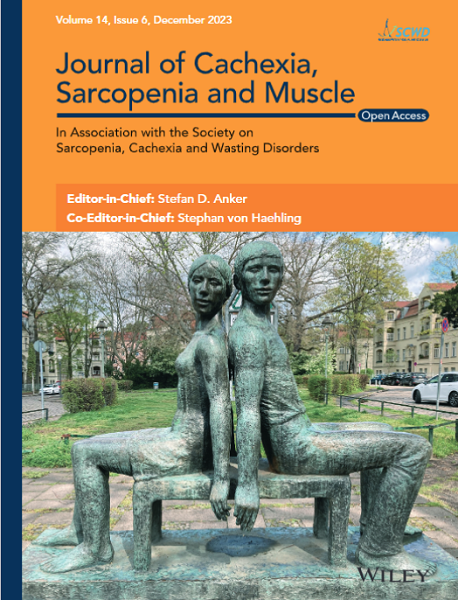Mitochondrial Dysfunction Contributes to Sustained Muscle Loss After Cardiac Surgery: A Prospective Observational Study
Abstract
Background
As a major systemic insult, cardiac surgery can lead to significant muscle loss, which increases the time to recovery as well as being correlated with mortality. Highly variable loss of muscle mass (0%–40% rectus femoris cross-sectional area [RFcsa]) and strength in the week after surgery has aided understanding of mechanisms of sarcopenia after acute illness. To include muscle recovery, patients' muscle phenotype beyond the first week after surgery and up to their return as outpatients was studied and correlated with protein and metabolomic markers.
Methods
Patients undergoing elective aortic valve surgery were recruited. Muscle mass (RFcsa), strength (handgrip, knee extension and spirometry), body composition (by bioimpedance) and health-related quality of life (generic questionnaire EQ-5D-5L) were determined pre-operatively, 7 days after surgery and at outpatient follow-up. Blood samples were taken on Days 0, 1, 3, 7 and follow-up. The plasma metabolome was determined in 20 patients at Days 0, 3, 7 and follow-up.
Results
Of 31 participants, 20 were male: mean age 68.8 years with a range between 48 and 85 years. Proportionate mean loss of RFcsa between pre-op and Day 7 values was 6.44% [95% CI 4.21 to 8.68, n = 31]; between pre-op and follow-up 9.69% [95% CI 4.92 to 14.96, n = 22]; and between Day 7 and follow-up 3.60% [95% CI −1.30 to 8.48, n = 22]. By contrast to measures of muscle bulk, the strength and functionality assessments (knee extension, handgrip, spirometry and short physical performance battery) decreased in the first week after surgery (pre-op to Day 7) followed by a return to baseline (Day 7 to follow-up). Health-related quality of life (cross-walk index) changed little over the course of the study but correlated positively at follow-up with muscle bulk (RFcsa: r = 0.58 [95% CI 0.19 to 0.81] p = 0.005) and strength of knee extension (r = 0.54 [95% CI 0.14 to 0.79] p = 0.010) and handgrip (r = 0.63 [95% CI 0.27 to 0.83] p = 0.002: n = 22). Both pre-operative and peak (Day 3) plasma levels of short-chain acyl-carnitine markers of mitochondrial dysfunction correlated with proportional muscle loss at follow-up and with strength at all timepoints.
Conclusions
Prolonged follow-up after aortic surgery demonstrated a divergence between the consistent recovery of strength and a significant proportion of patients continuing to lose muscle bulk. Markers of baseline and acute mitochondrial dysfunction predicted poor muscle outcomes up to outpatient follow-up.


 求助内容:
求助内容: 应助结果提醒方式:
应助结果提醒方式:


